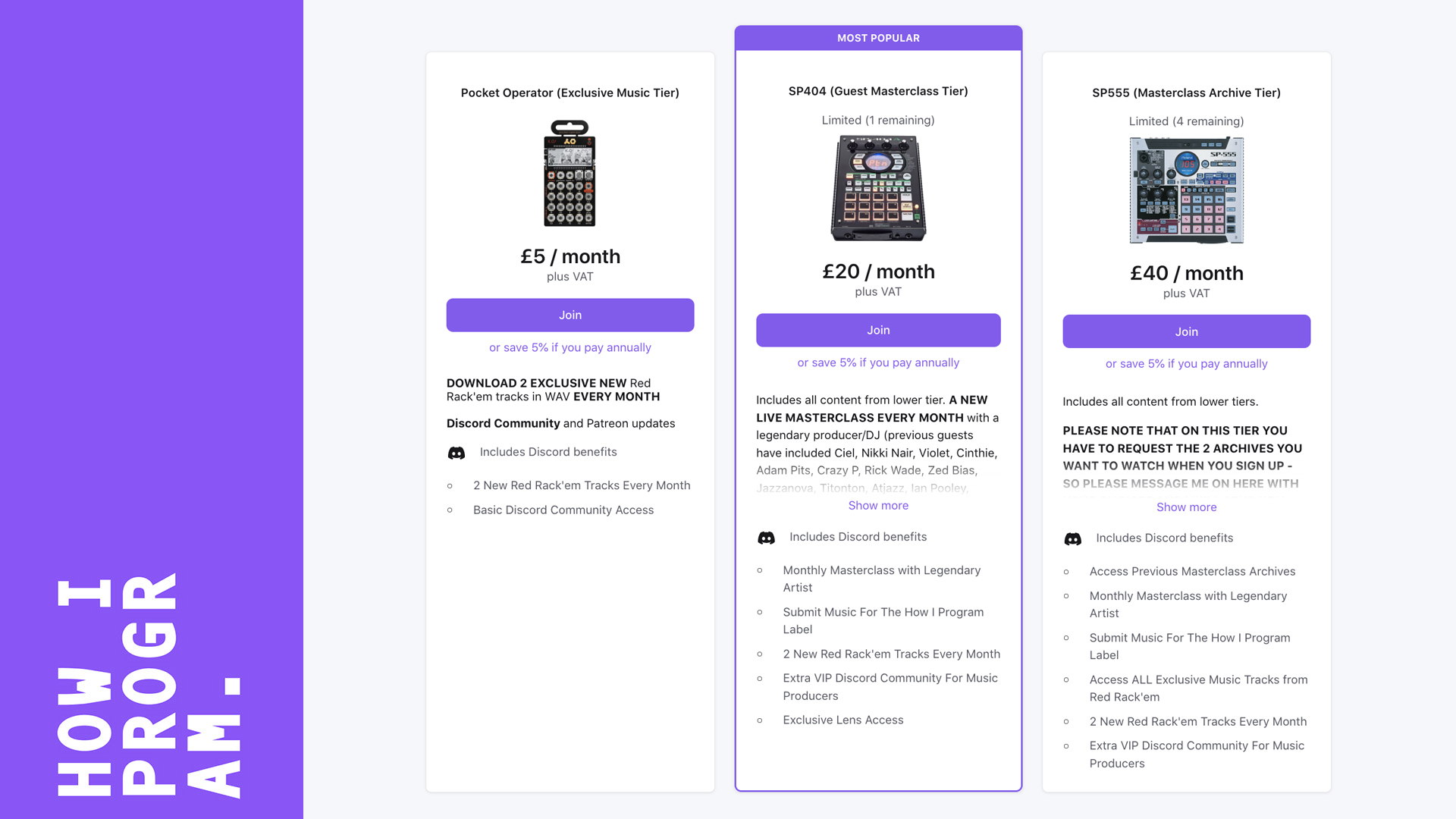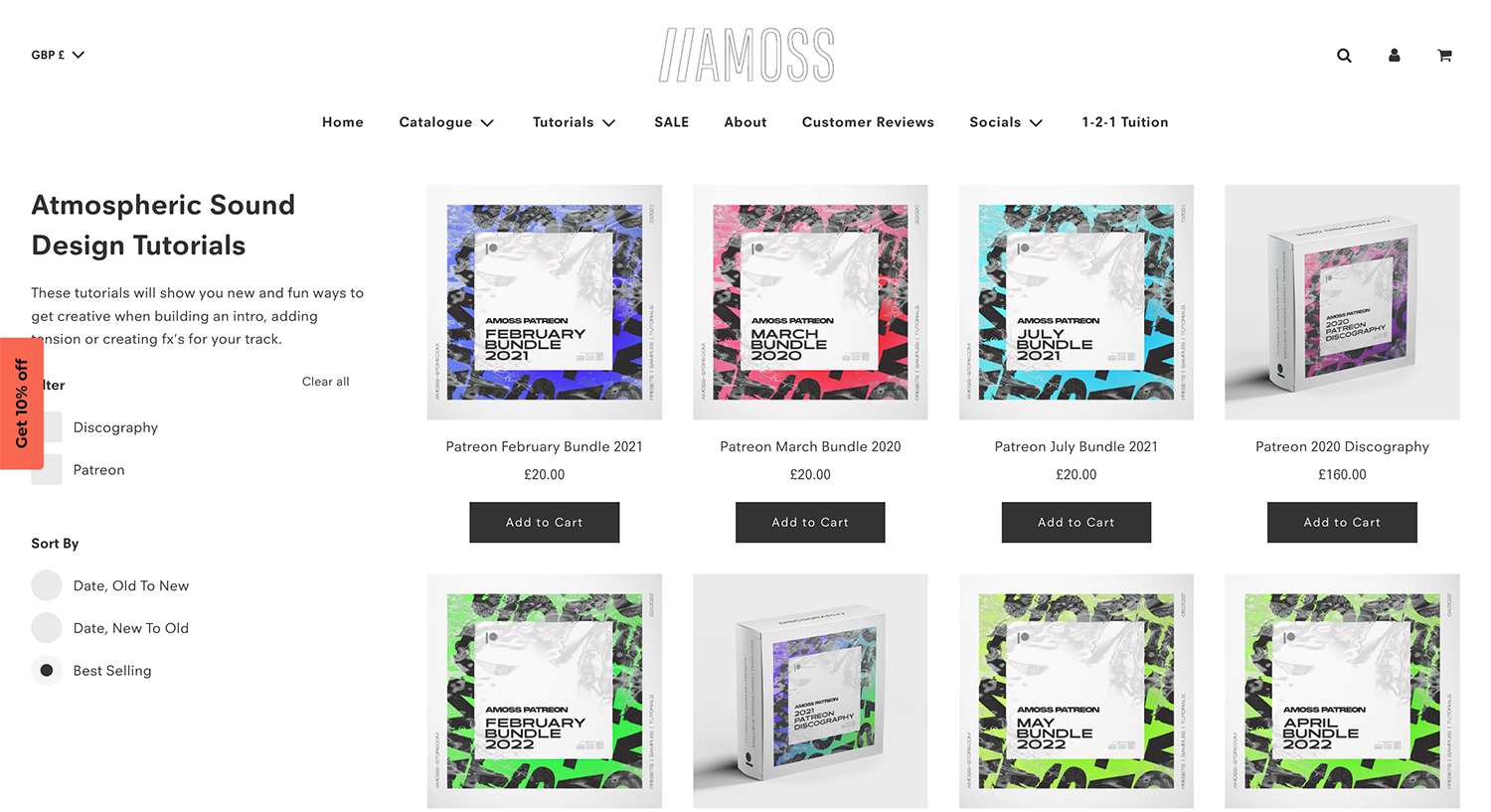In part three of our series on making money as a music producer, we speak with Bristol-based producers Red Rack’em and Amoss about diversifying into Patreon and how it’s transformed the way they earn from their craft.
Red Rack’em (Danny Berman) and Amoss (James Evans) have been releasing their music for over 15 years and performing across the globe. When COVID ground the live music scene to a halt in 2020, performers looked for ways to retain both their creativity and financial security. For Red Rack’em and Amoss, Patreon was an unexpected lifeline.
![[Portrait] Red Rackem_Photo-credit©SeanDelahay](https://insider.dbsinstitute.ac.uk/hs-fs/hubfs/%5BPortrait%5D%20Red%20Rackem_Photo-credit%C2%A9SeanDelahay.jpg?width=175&height=261&name=%5BPortrait%5D%20Red%20Rackem_Photo-credit%C2%A9SeanDelahay.jpg) Red Rack’em: "I started streaming on Twitch in April 2020. Everyone was doing it because we couldn't DJ. While I never made anywhere near enough to make Twitch worthwhile, it got me broadcasting from my home studio and helped me create a community - I had about 300 followers on there and a hardcore bunch of people who would come and tune in every time I went live. I started to think about where I could take this community, and after a lot of planning and support from some close friends, I decided to start my own Patreon in August 2020. I think it's really worth noting that although there were days when I was doing the Twitch to 10 people and questioning my life, it was a hugely important part of the process which led me to start the Patreon and ultimately where I am today."
Red Rack’em: "I started streaming on Twitch in April 2020. Everyone was doing it because we couldn't DJ. While I never made anywhere near enough to make Twitch worthwhile, it got me broadcasting from my home studio and helped me create a community - I had about 300 followers on there and a hardcore bunch of people who would come and tune in every time I went live. I started to think about where I could take this community, and after a lot of planning and support from some close friends, I decided to start my own Patreon in August 2020. I think it's really worth noting that although there were days when I was doing the Twitch to 10 people and questioning my life, it was a hugely important part of the process which led me to start the Patreon and ultimately where I am today."
[Photo credit: Sean Delahay]
.jpeg?width=175&height=233&name=Amoss%20Press%20Pic%20(2).jpeg)
Amoss: “I didn't really look at other avenues where I could use my skills until Patreon came along. It took a while for me to think about if I wanted to do it, how I would do it and how to begin approaching what people would want from me. There was a big internal battle of how can I do this; does anyone want what I have to share? I've never been educated formally within music and it's very weird trying to teach when you're being creative. Everything is inside of your head when you're working. You're thinking and you're making sounds, whereas with a tutorial style video, you have to vocalise your process as you're going through it - it's such a different thing - and I think that's taken me a long time to get used to.”
Like many artists transitioning to the world of live streaming and Patreon, the move opened up a whole new level of vulnerability, but also an audience neither knew existed.
Red Rack’em: "It was so nerve wracking. It's that feeling of putting yourself out there for criticism. I'm pretty confident when it comes to making records, DJing, broadcasting, and presenting - all those things I've done for 20 years - I know how to do them. Whereas doing Patreon and mentoring, I was absolutely starting from scratch. I was 44 then and it was really scary to be outside of my comfort zone again."
Amoss: “There was a lot of editing, a lot of not releasing videos because I didn't think they were good enough. There was definitely pressure in having a lot of followers from early on - I think I was up to 100 followers within the first month - and that blew me away.
“I was getting the kind of feedback which I wasn't really ready for. Some people were saying, ‘the way you teach makes so much sense to me’. All of that positive feedback really helped me progress in the way that I teach and deliver the content.”
Fears for tiers
At the core of Patreon is the tier system; a set of different price points that offers different benefits set by the channel's creator. For many, this is an early hurdle to overcome as you ask yourself, ‘what do people want and how much are they willing to pay for it?’
Red Rack’em: "I could have just created the ‘Red Rack’em Patreon’, but when you base it on your own artist career, unless you’re really famous, that is so finite in how far it can grow. I wanted to connect some of my favourite artists with less experienced producers in a grass roots setting and also help other producers with their music, and that’s where How I Program grew from. I can give my group something tangible, help them progress and also create a monthly programme of content.
.jpeg?width=2500&height=1604&name=Red%20Rackem%20press%20photo%20in%20front%20of%20sculpted%20wall%20(Photo-credit%C2%A9Sean%20Delahay).jpeg)
[Photo credit: Sean Delahay]
"My model is quite different from most people's, which is low cost tiers and a high volume of people. Whereas I wanted to provide something more open, intimate and friendly. I've been providing group mentoring for groups of 10 or less, track feedback and inviting handpicked guests to teach my group about production. This has created a genuine eco-system from all over the world with an amazing exchange of music and ideas. Since August 2020, we’ve had monthly masterclasses from Nikki Nair, Cinthie, Crazy P, Ciel, Bored Lord, Mousse T., Posthuman, Violet, Rick Wade, Zed Bias and many more amazing guests. Where else can you pay £20 to be in a small group having a 2.5 hour Zoom production tutorial with artists of that calibre?"
Amoss: “My tiers are pretty similar now to when I started, but I now offer two tutorials a month. Before I offered one, but I also offered an exclusive track every month, which I did for maybe a year and a half. It wasn’t sustainable though, so I was just really transparent with what I was doing with Patreon and if any changes were happening. I’m very much involved with the patrons and really value their input on what they’d like to see from the content I create.”
Growing and retaining your audience
Patreon subscriptions work on a rolling basis, which means that creators see constant fluctuations in the number of active monthly patrons. When Red Rack’em and Amoss made these channels, people had more time to engage with content, and for some, more disposable income to spend on it. Now, when managing money is more difficult than ever, we asked them how they not only grow but maintain their respective audiences.
Red Rack’em: "People are a lot more loyal than you would imagine. You can't expect people to always be there, but if you create a community, a safe space… people said it was life-changing, especially when we were in the depths of COVID. I am currently delivering an intensive 6 month one to one artist development course to 2 different producers who were both in the first ever mentoring group way back in August 2020! I am so grateful to meet people who believe in what I am doing and what I stand for as an artist.
"I usually have around 70-80 patrons in the group. Some are there for group mentoring. Some just watch the monthly masterclasses. Some are highly active on our Discord and some just lurk. It's all good! Something which has been a real game-changer has been the 'Masterclass Archive Tier' which gives new Patrons the chance to choose 2 previous Masterclasses to watch every month in addition to the new live one each month. This has brought a new audience into the group as often they will join up to watch a specific guest, then jump on our active private discord and discover this new friendly community and decide to stick around.
"The demographic my Patreon attracts is really mixed which is amazing! We've got younger producers who are just getting started rubbing shoulders with full hardware studio people with families who've been releasing for decades. We've had producers and DJs from all over the world including India, New Zealand, USA, Australia and lots of EU countries in the group. I love to see this mix of ages and tastes as that's how people gain good influences and expand their music."
.jpeg?width=2500&height=1670&name=Red%20Rackem_Photo-credit%C2%A9SeanDelahay%20(3).jpeg)
[Photo credit: Sean Delahay]
Attracting an audience doesn’t just have to be based on your profile and the content you offer. You have the opportunity to show your personality through small flourishes, too.
Red Rack’em: "Naming my tiers after hardware samplers like the SP404, SP12, MPC 3000… attracted real production heads to my group, because they're into DJ culture, hardware, sampling. You can tailor and create an audience just with these little things. I wanted to call them something that would be authentic. It's my homage to these iconic pieces of equipment, and it just happened to resonate with the people that joined."

Amoss saw his audience grow rapidly, with patron numbers plateauing around four months after first launching the channel and holding steadily in the three years the channel has been active. So what’s the secret behind this retention?
Amoss: “Consistency is key. For me, the quality can't dip from month to month, I don't want to delay anything. My content goes out on the second of every month, on the first my patron’s payments refresh, so everyone knows when and what's going to come out. I think it’s the reason why my numbers have remained consistent, because whether people leave or come back, they know what they're going to expect.
“I don't keep it all on Patreon, I have a website as well, so that it's fair for all subscribers. If someone has been subscribing for the last three years, they've given me X amount of money, and then someone comes along tomorrow and pays £12, and they get everything I've ever done; that's not fair on me, that's not fair on the loyal subscriber and it's not really fair for the person paying £12 to get everything.
“Maybe that's why I've got consistent numbers and patrons because they know they’re going to be there live and involved with it when it's first coming out. Then it goes on to the website, and it's a different price, so being part of the Patreon is a different feeling to just buying my product from my website.”

How to start your own Patreon
If you’re reading this article, it’s likely that you want to know how you can transition into Patreon yourself. You may also be thinking, ‘this is all well and good for Red Rack’em and Amoss, they have established audiences, but I don’t have that.’ So, we asked both of them for their thoughts on how Patreon might work for someone who doesn’t have a big profile.
Red Rack’em: “For people wanting to do their own Patreon, it can literally be about anything and you’ll find an audience for it. Not every idea is going to sustain you financially, but you have the freedom to really tap into a niche that you’re passionate about.
.jpeg?width=2500&height=1670&name=Red%20Rackem_Photo-credit%C2%A9SeanDelahay%20(5).jpeg)
[Photo credit: Sean Delahay]
Amoss: "I think I would have struggled to start this without having a fan base. I think the whole point of it is it's something based around what you're already creating - not to say it's impossible to ‘make it’ as a Patreon creator - but I think it's very hard for people to find that.
"It's asking people to give you their hard earned money and if you haven't got a reputation, then you've got to get that from somewhere and you've got to build that. Maybe for some people who want to get involved in Patreon, it's secondary to what they should be pushing, which is their brand, their music, etc. There must be so many artists out there, people who are painting or drawing for example, who have built a strong creative brand by posting on Instagram. They may not sell much, but they’ve tapped into an audience that is paying to watch them do more in-depth stuff on Patreon.
"As long as it reflects who you are, then I think people will be drawn to it… It's about finding what your niche is and how you want to present it.”
.jpg?width=1920&height=1079&name=Amoss%20Press%20Pic%20(1).jpg)
Starting your own Patreon isn’t just about deciding on the content you provide and the audience you want to tap into, there’s the nuts and bolts of making everything run smoothly and look the part. Account setup in Patreon is very user-friendly, but there’s all the subsidiary softwares that you’ll need to become au fait with. For the purposes of cost, the following suggestions are all free to use.
Discord
Look at anyone’s Patreon, regardless of channel size, and you’ll almost certainly find Discord bolted onto their tiers. It’s the best way to grow a community and feel intimately connected with your audience and gives you the opportunity to offer different levels of access based on the tier someone signs up to.
https://discord.com/
Canva
The visual identity of your Patreon doesn’t have to set the world on fire, but it should have a distinct feel to it. Canva is an excellent free graphic design tool that can help mitigate the costs of hiring someone to design assets for you and offers a wide array of templates to work with.
Email Clients
Staying connected with your audience is paramount to retaining them, so as well as Discord, you can set up regular emails to keep your audience up to date on future content, events, offers, etc. MailChimp offers a great free tier, but there are plenty of other email clients with free offerings.
Video Editing Software
If you’re creating tutorial content, then video editing software is a must-have. Tools such as DaVinci Resolve and Lightworks are free, multi-featured and cross-platform. For quick, social video creation there’s also Kapwing, though renders come with a watermark for free accounts.
https://www.blackmagicdesign.com/products/davinciresolve
https://lwks.com/
https://www.kapwing.com/
Zoom
The modern day shorthand for video calls, Zoom is an invaluable tool for Patreon; whether you’re running live online masterclasses, tutorials or 1:1 mentoring sessions. Free accounts can record sessions to their local computer, so you don’t necessarily have to worry about using screen capture software.
OBS Studio
Speaking of screen capture, OBS Studio is THE tool when live streaming, allowing you to create different scenes based on multiple feeds, custom overlays to personalise the look, in-built audio mixing and more.
Where you can’t get away with using free software is a good quality microphone and camera. You may only need the microphone, if your content doesn’t require you to be featured in it, and you can always use your mobile device as an upgraded webcam option, but it’s important to remember that you’re charging people for your content, and it should meet a certain standard.
New avenues
Talking with Red Rack’em and Amoss, it’s clear to see how Patreon has altered the way in which they can distil their expertise and still remain creatively fulfilled. While their positive experiences owe much to an already existing fanbase, to say that was entirely the reason would devalue the hard work and dedication they’ve each put in to make their channels successful.
While earning an income through the platform was the initial impetus behind their Patreons, the experience has not only enriched their sense of worth as artists, it’s opened up new avenues they never would have explored otherwise.
Red Rack’em: "Doing this and actually making a success of it, the support that I've had from other artists, but also the interest from the public, that's made me feel like I've created something which feels very different from my achievements as an artist. It feels far more 'life changing' than playing a good DJ set or having your records being hyped by the media or whatever."
Amoss: “It's pushed a few unknowns and boundaries away and allowed me to share my skill set in a different way, because for a long time I never really wanted to do that. I was self taught and I guess I had a bit more of an ego with it and felt like the knowledge I’d found was mine to keep. But it's benefiting no one for me to reserve this and I didn't really know how much desire there was for me to be sharing that. As soon as I started Patreon that just kind of opened up a different set of thought patterns and processes for me. That’s now moved on to me doing one-to-one tuition, which is something that I thought would be impossible for me.”
Next time
In the next instalment, we’ll be looking at the world of publishing and distribution and unpacking how you can bring your music to market. If you're new to this content series, be sure to check out our articles on ways music producers can make a passive income and three artists insights into making money as a music producer.
FIND OUT MORE
Red Rack'em Patreon
Amoss Patreon
8 ways music producers can make a passive income
How to make money as a music producer


